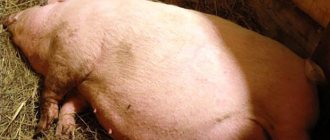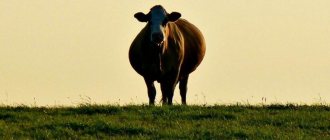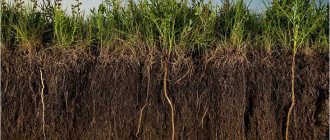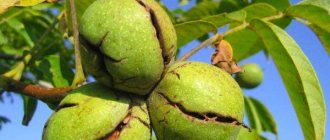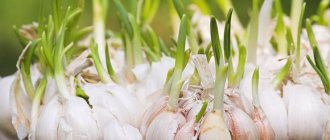The influence of breed on the weight characteristics of a pig
In modern pig farming, a large number of different breeds of pigs are known. They differ both in external parameters and in the result obtained, including weight:
- The Hungarian Mangalica has a thick coat that is reddish in winter, changing to white with cute curls in the spring. She looks a lot like a wild boar. This is due to the fact that genetically it is 40% related to its wild counterparts. Individuals of this breed are unpretentious in food; they can easily eat waste from alcohol processing, snails, frogs and a variety of root vegetables. They are not afraid of temperature changes and can feed on pasture until cold weather. This breed is classified as a greasy breed. Hungarian mangalitsa meat is considered valuable because it can retain its pleasant taste for 10 months. Representatives of this breed can gain weight up to 180 kg.
- One of the ancient breeds of pigs is the Mainshan breed. Like the Hungarian Mangalica, it is considered a greasy breed. Individuals have black hair, a shortened, one might say, flattened snout, and the longest and drooping ears among all other pig breeds. Representatives of Mainshan have folded skin. This breed is prolific. A sow can give birth to 12 to 18 piglets at a time. If we talk about the weight characteristics of the breed, then they are perhaps the most record-breaking ones available. Boars with a body length of 70 centimeters gain up to 200 kg, and females, whose height is 63 cm, have a body weight of 170 kg.
- A rare breed of pigs raised is the Taiwanese Green Luminous. She was bred in Taiwan. The breed got its name because newborn piglets have a greenish color, and under ultraviolet rays they seem to glow, their color becomes bright green. The weight of representatives of this breed is not a record. One and a half year old piglets have the same weight as regular ones, it is 120-140 kg. This breed is bred more for medical purposes than for economic purposes.
- The Danish proletarian pig was bred by the Danes who lived in Germany. It has an unusual coloring, reminiscent of the flag of Denmark. This breed is quite well-fed. A pig can weigh 350 kg.
- Among the wide variety of massive pigs, miniature pigs belonging to the Kun-kun breed were also bred. They are endowed with an unusual body shape that resembles a ball. Representatives of this breed have a variety of colors. There are individuals of red, gray and black colors. Adult pigs reach a weight of 13-14 kg, with a height of 80-90 cm.
Average weight of a pig at different ages
How to measure the weight of an adult pig
Adults should be considered pigs that have completed their growth, that is, animals older than 9 months.
The following methods have been developed for measuring live weight without weighing:
- Measurement according to the table.
- Calculation using formula.
- Calculation by fatness category.
Measuring by table
To calculate the live weight of a pig, use a measuring tape. It is most convenient to use a one and a half meter tailor's tape. The procedure is carried out in the morning, on an empty stomach. Make sure the animal stands upright. To do this, the assistant offers her a treat from his hand.
First, determine the length of the body. The tape is applied to the back of the head and pulled to the base of the tail. The second measurement is the circumference behind the shoulder blades.
The next stage is determining the weight using the table. It can be copied from a publication on the Internet and printed. The mass of the animal is determined at the intersection of rows and columns.
Calculation by formula
Formulas for calculating weight using the same measurements are provided online. For example, the following formula is recommended:
where B is the weight of the animal, D is the length of the body, O is the girth behind the shoulder blades. The result of the calculation is 133 kg. Tabular and calculated results vary widely. Table data was developed by comparing measurements with weighing results. Therefore, it is better to use them rather than formulas.
Calculation by fatness category
A formula has been developed for calculating live weight as the product of body length and chest girth divided by a coefficient, which for pigs of average fatness is 156. The result is a greatly underestimated result, in our example 79 kg. Therefore, it is better to use the weight determination according to the table.
Determining body condition is of practical importance for correcting the diet of pregnant sows. The figure shows the appearance of pigs with different fatness categories.
How to find out how much a piglet weighs
The weight of piglets at birth, as well as in the first weeks of life, is determined on portable scales. Further determination is carried out in an evaluative way according to growth change tables. However, upon reaching a weight of 25-30 kg, it is necessary to separate individuals for herd repair and fattening. The feeding schedule for gilts will be different. This is where measurements come in handy.
Piglet weight table by week
The approximate weight of piglets by week of rearing is shown in the table:
| Age, weeks | Live weight, kg |
| 1 | 2,5 |
| 2 | 4,5 |
| 3 | 7 |
| 4 | 9 |
| 5 | 11 |
| 6 | 14 |
| 7 | 18 |
| 8 | 22 |
| 9 | 26 |
| 10 | 30 |
Therefore, measurements should be carried out at the 9-10th week of the piglet’s life.
Weight of piglets by month: table
After placement for fattening or raising replacement young stock, selective monitoring of the live weight of gilts is recommended to be carried out monthly.
Visually select at least 5 medium-sized individuals from each cell, take measurements and compare with the approximate growth plan presented in the table:
| Age, months | Live weight, kg |
| 3 | 39 |
| 4 | 45 |
| 5 | 65 |
| 6 | 85 |
| 7 | 110 |
Selling for meat is carried out upon reaching a live weight of 90-110 kg. Further fattening is impractical, since growth occurs due to lard, the market value of which is lower than meat.
Piglet weight gain according to age standards
The added weight of piglets depends on external and internal parameters. Feeding schedule and housing conditions are important external factors. In addition, pigs of different breeds give birth to babies of different sizes.
Determining the weight of pigs using the table gives a complete picture of the dynamics of the process. Under favorable conditions, two-month-old pigs weigh 20-25 kg, and in 6 months their weight exceeds 100 kg. Knowing these indicators allows you to control the correctness of the feeding ration.
In addition, determining the weight of a pig by size is the basis for calculating the slaughter yield of meat. Of the 100% mass of a slaughtered animal, bones make up 10%, lard - 20%, meat - 70%. Thus, it is important to control pork weight at each stage of fattening, focusing on the final result.
If you liked the article and aroused interest, then please like it.
Write in the comments if you have ever used formulas and tables to determine the weight of pigs.
Why do you need to know the weight of a pig?
Only a few, even among experienced farmers, can determine the weight of a pig without a scale. Meanwhile, this skill provides the breeder with a number of advantages and helps to increase the efficiency of raising livestock.
The exact weight of a piglet, when determined periodically, allows one to calculate the rate of weight gain in the animal. As a result, knowing the average values for a particular breed, one can judge the effectiveness of the diet used to feed young animals and adjust it if the results are unsatisfactory. In this case, the menu is supplemented with various vitamins and more nutritious foods.
Attention! Detection of a steady decline in a piglet’s weight may be the main sign of a developing disease, which will subsequently help to organize timely treatment measures. The weight of an adult pig will allow you to accurately calculate the daily amount of feed for the animal and the composition of the diet
This will allow the breeder:
The weight of an adult pig will allow you to accurately calculate the daily amount of feed for the animal and the composition of the diet. This will allow the breeder:
- more rational use of available feed reserves;
- increase weight gain in the animal;
- prevent obesity;
- improve the taste of meat before slaughter.
But it is worth noting that the measurement methods listed below provide only approximate values for the weight of a pig, assuming a certain error. Therefore, in the case of selling pork after cutting, it is recommended to weigh all meat products on conventional electronic scales.
Pig weight: determining ranges for different ages and breeds
Many pig breeders are wondering how to determine the average weight of their pets. This parameter is very important to monitor how correctly young animals are developing and how high-quality weight gain is in adults. There is nothing complicated about this; simple and accurate methods for measuring weight have already been developed that even beginners can handle.
What do weight indicators depend on? To properly create a diet, you need to know the average weight of pigs at each life stage. This will help make timely adjustments to the volume of feed, as well as determine the frequency of feedings.
Knowing the averages, the owner must remember that there are differences between breed groups of animals. The piglets of a large white pig will be much larger than their peers of the Asian herbivorous breed.
How much does an average pig weigh?
The weight of the animal depends on gender, age group, breed characteristics and method of feeding. The average weight of an adult pig varies from 150 to 300 kg; of course, there are also record holders who gained weight over 1 ton. You can also meet miniature representatives who weigh no more than 30 kg. However, farmers practically do not deal with such breeds.
Each owner chooses one breed or another. The animal may be of the meat or grease type. In the latter, fat is deposited more actively after the pig is six months old. The difference in the meat direction is the active growth of muscles.
Landrace
Meat-fat breeds can be called intermediate; their fat and muscles are equally distributed.
On average, weight categories depend on the breed. For example, you can take the producer of the steppe white, which can gain more than 300 kg, and the Vietnamese - up to 140 kg. Young animals gain weight depending on their diet and how the queen fed during pregnancy. Proper, regular feeding leads to the fact that the weight of newborns can vary from 1000 to 1500 g.
In the following table you can see weight data by breed for pigs
Siberian northern
Until the age of 30 days, babies have a suckling period, and here the weight gain depends on the mother’s milk indicators.
Diet plays a key role in weight gain. If you give animals concentrated feed, then the weight gain will be more impressive. In the event that the food supply is represented by:
- green mass;
- vegetable crops;
- fruits;
- root vegetables,
You will notice that the animals will gain weight rather slowly. Knowing the average weight of a piglet, as well as the compliance standards for each month, you can plan feeding in such a way as to obtain maximum weight gain.
In the following table you can see data on approximate estimates of weight in young animals from 1 to 4 weeks of life.
Subtleties of weight measurement
Any owner can easily find out how much his livestock weighs. The developed methods will help with this; the main thing is to have a measuring tape, a table or know the formula on hand.
Most experienced livestock breeders can determine offhand how much weight a pig has gained. However, this method is not very accurate. But having knowledge of some parameters of the animal’s body, it is possible to make more accurate calculations. The owner must know the girth behind the shoulder blades and the length. These measurements are already being compared with the figures in the table.
Murom breed
To find out the length of the body, the tape is applied to the middle of the occipital region and a measurement is taken along the spine to the root of the ponytail.
You need to remember the resulting numbers and find them in the table where the columns with values intersect.
Meat
Despite the fact that lard is a very popular product on the market, it is still the meat that causes the mass breeding of pigs. Here, ordinary fattening is not suitable, since the main goal of such farming is meat.
When such an animal goes under the knife, the pig’s meat has a very delicate aroma and “delicious” taste. But for cultivation on a farm scale, this is a very important indicator, which is also worth mentioning.
A small table will help you keep track of the animals’ weights, which lists the weight criteria by month.
| Age of meat pig | Live weight of the animal | Meat to live weight ratio | Notes | Weight of body parts and organs |
| At 4 months | 42-47 kg | 50% meat, 50% everything else | Vietnamese pig reaches only 30 kg at 4 months | Pig head - 3-4 kg Heart 200-250 grams Kidneys 80-100 grams each |
| At 6 months | 71-76 kg | 60% meat, 40% everything else | A Vietnamese pig reaches only 55 - 60 kg at 6 months | Head weight – 6-8 kg Heart – 280-300 grams Kidneys 120-150 grams each |
| At 7 months | Up to 95 kg | 60% meat, 40% everything else | The weight of Vietnamese pigs at this age does not exceed 75 kg | Head weight 8-10 kg Heart – 320-350 grams Kidneys 160-180 grams each |
| At 8 months | 103 -107 kg | 63% meat, 37% everything else | Weight of Vietnamese pigs – 75-80 kg | Pig head – 9-11 kg Heart – 320-350 grams Kidneys 180 grams each |
| At 10 months | 125-140 kg | 65% meat, 35% everything else | Vietnamese breed – 90 kg | Head weight – 10-12 kg Heart – 320-350 grams Kidneys 180 grams each |
| One year old potbellied pig, Landrace, Great White or any other meat breed | 160-180 kg (in rare cases 200+ kg) | 67-70% meat, 33-30% everything else | Vietnamese breed of pig – 90 kg (in rare cases 100+ kg) | Pig head – 13-15 kg Heart – up to 400 grams Kidneys up to 200 grams |
Now you know how much a pig weighs on average throughout its life
It is very important to send pigs to slaughter on time; a mature pig produces very coarse meat and lard. It became clear what a black pig is and how much meat it contains, that such “Vietnamese” are suitable only if you are not going to be particularly diligent about messing around with pigs, since the breed itself is very strong
But that's not all. Among other things, there are also bacon breeds of pigs.
Delicious bacon
An ordinary meat breed pig is suitable for bacon; it’s all about proper nutrition. Initially, the animal is fed high-calorie food, namely cereals, for 2 weeks. After this, a small layer of fat appears on the pig. For the next 3 weeks, the animal is fed grass, milk, bread and sunflower waste.
During this time, the domestic pig builds up a layer of muscle over fat, and so on. This is how you can get delicious bacon.
As for the weight at slaughter, it can be taken from the table about meat breeds, there is no difference. The best choice for such purposes is a well-fed Landrace uterus, which, due to its body structure, can produce quite a lot of bacon. An excellent option for slaughtering for bacon would be an animal aged 7-8 months.
No matter how much a pig weighs, any animal under 1 year of age is suitable for slaughter. Although many restaurants around the world have special recipes for preparing delicious dishes using “old” meat. During fattening with neglect of nutritional standards, pigs often fall on their feet and die for no good reason
The reason for this is severe obesity, which reduces heart function. The largest pig in the world, nicknamed Big Norma, simply amazed the Nobel representatives with scales of 1.2 T. How an ordinary pig gained such weight is kept secret by the owner of BN. Big Norma replaced the Old Slot, which, due to a number of genetic disorders, weighed more than 6 tons! How many kilograms a live pig weighs can be found out not only by using scales, but also by a simple table that will allow you to find out the weight of a pig in a matter of minutes. In live weight A pig's meat is usually as much as lard, giblets, skin and bones combined.
This is all that everyone who wants to raise healthy and “useful” animals, such as pigs, should know about
Proper nutrition is very important for such animals in order to get from them what you need. Remember that a pig always weighs significantly less meat compared to live weight
Rate food so that the weight of the animals corresponds to the standards (given in the table). You should not rush to slaughter, but it is not advisable to debug it either; everything must be completed on time and in accordance with the weight indicators.
Weight table - pig weight characteristics and measurement methods
Why you need to know this and how you can determine the weight and size of an animal
Often a situation may arise when it is simply necessary to know the weight of a pig, but there are no suitable scales at hand. First of all, this is the calculation of the required amount of feed. Complete and sufficient nutrition is the main secret to the success of raising pigs, so it will be useful to calculate the volume of feed in advance.
Scheme for measuring a pig to find out the weight without weighing.
Find out what the Petrena breed looks like here.
When selling a pig for meat, it is still advisable to use electronic equipment, but to be on the safe side, you can at least roughly “estimate” at home.
How to measure the live weight of a pig using a table without scales
For reliable information it is necessary to measure the animal. When calculating, two indicators are needed: the length of the torso and the volume of the chest, measured under the shoulder blades. For convenience, you can use a tailor's measuring tape. The table data varies with an error of 4 to 11%.
Pig weight chart by size
| Weight, kg: | Chest circumference under shoulder blades, cm: | |||||||||||||||||||||
| 60 | 64 | 68 | 72 | 76 | 80 | 84 | 88 | 92 | 96 | 100 | 104 | 108 | 112 | 116 | 120 | 124 | 128 | 132 | 136 | 140 | 144 | 146 |
| Length tulo- things, see: | 38 | 11 | 13 | 15 | ||||||||||||||||||
| 42 | 13 | 14 | 16 | 18 | ||||||||||||||||||
| 46 | 14 | 16 | 18 | 20 | ||||||||||||||||||
| 50 | 15 | 17 | 19 | 22 | 24 | 27 | ||||||||||||||||
| 54 | 16 | 18 | 21 | 23 | 26 | 29 | 32 | |||||||||||||||
| 58 | 17 | 19 | 22 | 25 | 28 | 31 | 34 | 37 | ||||||||||||||
| 62 | 18 | 21 | 24 | 27 | 30 | 33 | 37 | 40 | 43 | |||||||||||||
| 66 | 19 | 22 | 25 | 28 | 32 | 35 | 39 | 42 | 46 | 50 | ||||||||||||
| 70 | 24 | 27 | 30 | 34 | 37 | 41 | 45 | 49 | 53 | 58 | ||||||||||||
| 74 | 28 | 32 | 36 | 39 | 44 | 47 | 52 | 56 | 61 | 66 | ||||||||||||
| 78 | 37 | 41 | 46 | 50 | 55 | 59 | 65 | 70 | 76 | |||||||||||||
| 82 | 39 | 43 | 48 | 52 | 57 | 62 | 69 | 74 | 79 | 85 | ||||||||||||
| 86 | 46 | 51 | 55 | 60 | 65 | 71 | 77 | 82 | 89 | 96 | ||||||||||||
| 90 | 53 | 58 | 63 | 68 | 75 | 81 | 94 | 101 | 108 | |||||||||||||
| 94 | 60 | 66 | 71 | 78 | 85 | 91 | 105 | 113 | 120 | |||||||||||||
| 98 | 69 | 74 | 81 | 88 | 95 | 101 | 110 | 118 | 125 | 133 | ||||||||||||
| 102 | 78 | 85 | 92 | 99 | 106 | 114 | 123 | 131 | 139 | 147 | ||||||||||||
| 106 | 88 | 95 | 103 | 110 | 119 | 127 | 136 | 144 | 153 | |||||||||||||
| 110 | 99 | 107 | 114 | 123 | 132 | 141 | 149 | 158 | 170 | 180 | ||||||||||||
| 114 | 111 | 119 | 128 | 137 | 146 | 155 | 176 | 186 | 196 | |||||||||||||
| 118 | 123 | 132 | 142 | 151 | 160 | 170 | 182 | 193 | 203 | 215 | ||||||||||||
| 122 | 137 | 146 | 156 | 166 | 176 | 188 | 199 | 210 | 222 | |||||||||||||
| 126 | 151 | 161 | 171 | 181 | 194 | 205 | 217 | 229 | ||||||||||||||
| 130 | 166 | 177 | 187 | 200 | 212 | 224 | 236 | |||||||||||||||
| 134 | 182 | 193 | 206 | 218 | 230 | 244 | ||||||||||||||||
| 138 | 199 | 212 | 225 | 237 | 251 | |||||||||||||||||
| 142 | 219 | 231 | 244 | 258 | ||||||||||||||||||
| 146 | 238 | 251 | 266 | |||||||||||||||||||
| 150 | 258 | 273 |
How to find out pork weight using coefficients
This scheme can be safely called the most approximate, but it is suitable if the above table is not at hand. The dimensions of the pig in this case are also taken as in the above table. Read here what and how to feed laying hens correctly.
The calculation algorithm is extremely simple:
- Multiply the measurement data together (dimensions in centimeters).
- Determine the size of the animal’s fatness offhand. The coefficients below define three stages: Fairly thin pig k=162.
- Average fatness k=156.
- Normal and good fat content k=142.
A visual diagram for determining the fatness of an animal.
For clarity, you can use the example from the table below:
- The length of the pig's body will be 70 centimeters.
- The circumference under the shoulder blades will be 84 centimeters.
- We will accept fatness as normal, so the appropriate coefficient will be 142.
Weight calculation:
70×84=5880.
5880/142=41,4.
According to the table, the weight of the pig should be 41 kg. Taking into account the error, this result will be quite satisfactory. You may also be interested in photos of the Mangal breed.
Scheme for measuring the weight of a pig according to its age
There are simply no exact guidelines and tables for weight gain, because the determining criterion will be a complete and balanced diet, which can be provided exclusively in farm conditions, and not for home use.
Indicative weight gain table for piglets
| No.: | Animal age: | Animal weight, kg: | |
| Period: | Days: | ||
| 1. | From birth. | 1-7. | 2,6. |
| 2. | Second week. | 8-14. | 4,4. |
| 3. | From 2 to 3 | 15-21. | 6,4. |
| 4. | From 3 to 4 | 22-28. | 8,9. |
| 5. | From 4 to 5 | 29-35. | 11,6. |
| 6. | From 5 to 6 | 36-42. | 14,5. |
| 7. | From 6 to 7 | 43-49. | 17,5. |
| 8. | From 7 to 8 | 50-56. | 21,0. |
| 9. | 8 to 9 | 57-63. | 24,9. |
| 10. | From 9 to 10 | 64-70. | 29,0. |
| 11. | From 10 to 11 | 71-77. | 33,5. |
| 12. | From 11 to 12 | 78-84. | 38,4. |
| 13. | From 12 to 13 | 85-91. | 43,4. |
| 14. | From 13 to 14 | 92-98. | 48,6. |
| 15. | From 14 to 15 | 99-105. | 53,9. |
| 16. | From 15 to 16 | 106-112. | 59,4. |
| 17. | From 16 to 17 | 113-119. | 65. |
| 18. | From 17 to 18 | 120-126. | 70,9. |
| 19. | From 18 to 19 | 127-133. | 76,9. |
| 20. | From 19 to 20 | 134-140. | 83. |
| 21. | From 20 to 21 | 141-147. | 89,1. |
| 22. | From 21 to 22 | 148-154. | 95,4. |
| 23. | From 22 to 23 | 155-161. | 101,5. |
| 24. | From 23 to 24 | 162-168. | 107,6. |
| 25. | An adult animal. | 169-175. | 113,7. |
| Total: | 175. | 113,7. |
How much does a pig weigh?
Great White piglets are rarely born weighing more than 1 kg. The larger the piglet at birth, the more productive it will be in the future. Babies of the Vietnamese breed are born almost twice as small - 500-600 g.
For the first month, piglets live on their mother’s milk, so they gain weight very quickly, and a piglet weighing 8-9 kg by the end of 4 weeks is quite normal.
The weight of piglets largely depends on the conditions of detention and, most importantly, a well-formulated diet. If the owner approaches the matter of rearing with knowledge of all the nuances, then the weight of the piglet is already 2 months. averages 25 kg. From this moment they begin to intensively fatten him, and by the age of 4 months. their weight doubles.
At 6 months (or a little later), when the young animals reach a weight of 90-110 kg, commercial fattening ends and they are transferred to the gilt department.
How much a pig should weigh by month can also be found in the table:
| Age in weeks | Age in days | Number of days in the period | Live weight at the end of the period, kg |
| 1 | 1-7 | 7 | 2,6 |
| 2 | 8-14 | 7 | 4,4 |
| 3 | 15-21 | 7 | 6,4 |
| 4 | 22-28 | 7 | 8,9 |
| 5 | 29-35 | 7 | 11,6 |
| 6 | 36-42 | 7 | 14,5 |
| 7 | 43-49 | 7 | 17,51 |
| 8 | 50-56 | 7 | 21,01 |
| 9 | 57-63 | 7 | 24,93 |
| 10 | 64-70 | 7 | 29,06 |
| 11 | 71-77 | 7 | 33,54 |
| 12 | 78-84 | 7 | 38,4 |
| 13 | 85-91 | 7 | 43,4 |
| 14 | 92-98 | 7 | 48,6 |
| 15 | 99-105 | 7 | 53,9 |
| 16 | 106-112 | 7 | 59,4 |
| 17 | 113-119 | 7 | 65 |
Finding out your live weight in a quick and hassle-free way is not such an idle question. This indicator may indicate the correctness or unsuitability of the diet used during fattening. In addition, when handing over the animal for slaughter, the owner will have at least an approximate idea of the expected profit and will be able to control the situation.
Author's rating Author of the article Ivanov Semyon Sergeevich Farmer with 23 years of experience. Agronomist by training. Rural resident for reasons of principle. 271 articles written
Raising pigs at home can be quite a profitable activity, but to account for productivity and a number of other tasks, it is necessary to know the exact weight of the animal. At the same time, not every farm has scales of the required configuration. In this case, a very useful skill for the breeder will be the ability to find out the weight of a pig without scales. This can be done in several ways, each of which requires detailed consideration.
Pig weight measurement
How to determine the weight of a pig without scales
There are several proven methods that make it possible to determine the weight of a pig without professional scales.
Measuring by table
To calculate the weight of piglets using specially designed tables, it is necessary to make the appropriate measurements using a tape measure. Experienced livestock breeders also recommend using a 1.5 m long tailor's tape for these purposes. Measurements are taken in the morning, while the animals have not yet eaten. Make sure the pig stands upright. To do this, it is better to use an assistant who will hand-feed her with her favorite food.
First of all, you need to determine the length of the body. To do this, a tape measure or tape must be attached with one end to the back of the head and the other to the base of the tail. After this, measure the girth behind the shoulder blades. Based on measurements, weight is determined using a special table. It can be found in the livestock breeder's directory and made a photocopy. The intersection of rows and columns will show the resulting mass of the pig. Weight calculation based on dimensions is accurate. This method is used not only by livestock breeders themselves, but also by professional butchers. The error is approximately ±12%.
Calculation by formula
You can also calculate the weight of a pig using the developed formula by taking the appropriate measurements using a tape measure. It looks like this:
M=0.99·D+1.54·O-150,
where M is the mass of the pig;
D - body length of the pig;
O - girth behind the shoulder blades.
Calculating the mass in this case will not present any difficulties if the measurements are taken correctly. It is worth keeping in mind that the data obtained from the table and calculated using the formula are very different. As practice shows, tabular data is accurate, therefore it is recommended to use them.
The presented method does not make it possible to determine the weight of a newborn piglet. In this case, you will still have to use scales. It is not necessary to purchase professional ones; ordinary household ones will do. As you gain weight, you will no longer need to weigh the animal, but you will be able to measure it and find out how much it weighs using the same tables or calculate it using the formula.
Calculation by fatness category
Another method has been developed for calculating the live weight of pigs according to fatness categories. To do this, you need to multiply the length of the body by the girth behind the shoulder blades and divide by the coefficient. For piglets of average fatness, the value of this coefficient is taken to be 156.
Determination of fatness is necessary when it is necessary to adjust the diet of pregnant queens. According to certain criteria, the following categories of fatness are distinguished:
- Skinny - the hips and spine are expressed in relief.
- Thin - the spine and hips can be easily felt by applying light pressure with the palm of your hand.
- Medium - with strong pressure with your palm, you can feel the spine and hips.
- Above average, the hips and spine cannot be felt.
- Fatty - the spine and hips are hidden and cannot be felt.
To normalize weight, it is recommended to feed skinny animals 4 kg of compound feed daily, and fat animals - 2 times less.
The weight of small piglets is initially determined using growth charts or using portable scales. Next, when they gain 25-30 kg, individuals are separated for fattening and for renewing the herd. They are given different nutritional plans and measurements are taken monthly. Slaughter occurs when the pig reaches a weight of about 100 kg. It is not advisable to feed her further, since weight gain occurs due to lard, the cost of which is lower than the cost of meat.
How to measure the weight of an adult pig
In order to find out the real weight of the animal and compare it with how much an adult pig weighs on average, you will need a measuring tape, a special table, calculation formulas and a calculator. In pig farming, three methods for determining weight are used, differing in accuracy.
Measuring by table
If you do not have enough experience in pig farming to determine the weight of animals by eye, you will have to take some measurements. You need to know only two parameters: the length of the body from the back of the head to the beginning of the tail and the girth of the chest behind the shoulder blades. When taking measurements, the head should be directed forward, not tilted, and be on the same axis with the body, so the animal will have to be occupied with something for a while.
To simplify the measurement, you need to follow some rules:
- The animal must be measured early in the morning;
- The pig does not need to be fed before measuring;
- You should use a soft tape without pressing it into the skin of the animal, so as not to cause discomfort and to maintain the accuracy of measurements.
The resulting dimensions are looked up in a special pig weight table (shown above), which lists possible body lengths vertically and chest girths horizontally. In the cell at the intersection of parameters is the approximate mass of the animal. The measurement error in this case is 4–11%.
Calculation by formula
To compile the table, a special formula is used, according to which you can calculate the weight of the animal with higher accuracy yourself.
Live weight = 1.54 × X + 0.99 × K – 150
Where:
- X - chest circumference in cm;
- K - body length in cm.
The accuracy in this case is higher, but a couple of % can be subtracted from the result if you take into account a certain amount of food consumed.
Calculation by fatness category
A more accurate formula is based on fatness. It is also more convenient, since you can use it to find out the weight of a pig without scales and a table. To use it, you also need to know the length of the body and the girth of the chest, but the coefficient (which is equal to 150 in the previous formula and is the same for all cases) changes depending on how fat the individual is.
Live weight = (X × K)/N
Where:
- X - chest circumference in cm;
- K - body length in cm.
- N is the fatness coefficient. It is equal to 142 for fat, 156 for medium and 162 for thin animals.
The fatness category is determined by the appearance of the animal in accordance with GOST. In this case, several parameters are assessed:
- Body shape;
- The thickness of the bacon, determined by touch by palpability of the vertebrae of the thoracic spine;
- Gender and age.
Fat, or greasy, pigs have rounded shapes, their neck merges with the shoulder blades, the back is wide and smooth, without visible outlines of individual parts. The lard has a thickness of 7 cm, the vertebrae cannot be palpated. Also classified as fat are semi-greasy pigs, which have the same characteristics, only their bacon can be 5–7 cm thick.
Nutrition category: fatty or greasy
Normal, ham and bacon pigs, which fall into the average fatness category, have backfat 3–5 cm thick, and the fat is hard to the touch. The body is straight, the stomach does not sag. The spinal processes can be felt by pressing firmly on the skin in the area of the 6th and 7th thoracic vertebrae. The weight of an adult pig in this category does not exceed 110 kg.
Fat category: normal, ham and bacon
Thin, or meat, pigs have backfat 1.5–3 cm thick, the vertebrae are easy to feel, but they do not protrude through the skin. Signs of fatness are weak, with a visible interception behind the shoulder blades.
Fatness category: thin or meaty,
Thus, it is not necessary to be a specialist to determine live weight with sufficient accuracy - a table of pig weights will help novice pig farmers, and with experience it will be possible to weigh the animal by eye. The described methods can be used not only to find out the weight of a boar, but also to measure a pig - the same formulas are used. The only difference between individuals of different ages is that very small piglets can be measured on scales, simply by holding them in your arms.
Pig weight table by measurements (kg)
How to determine the weight of a pig from measurements?
If you are involved in pig farming, it will not be amiss to know that there are five groups of pig fatness.
1 pig fatness group. These are young animals up to 8 months old for bacon, fattened on special feed. The first group includes white pigs, without pigmented spots, traumatic injuries, tumors, or bruises. In this case, the length of the body must be at least 1 meter. The weight of such pigs ranges from 80 to 105 kilograms. Another important criterion is that the thickness of the backfat between the sixth and seventh thoracic vertebrae, above the spinous processes (without the thickness of the skin), should be from 1.5 to 3.5 centimeters.
2 pig fatness group. This is young meat with a live weight of 60 to 130 kilograms. In the mentioned area, the thickness of the bacon should be from 1.5 to 4 centimeters. This also includes gilts with a back fat thickness of 1 cm and a weight of 20 to 60 kilograms.
3 pig fatness group. These are fatty pigs, including sows and hogs, with a back fat thickness of at least 4.1 cm.
4 pig fatness group. These are sows and hogs weighing over 130 kilograms with a backfat thickness in the mentioned area from 1.5 to 4 centimeters.
5 pig fatness group. These are suckling pigs with white or slightly pink skin, without bruises, rashes, swelling, bites or wounds.
You now know how to measure the weight of a pig - a table of pig weights based on measurements will help you with this. By the way, in the same way you can find out the weight of cattle and young cattle. If you are interested in the features of raising newborn piglets, the rules for feeding piglets, feed for pigs, as well as the features of lard, meat and bacon fattening, you can learn about this from our separate articles.
Pig measurements
In a home or small farm setting, it is not always possible to weigh an adult pig to determine its weight. To determine the most accurate weight without weighing, you can use the measurements of the pig. In this case, it is necessary to measure two distances (measurements). Measurements are taken 2-3 hours before the animal’s daily feeding, that is, on an empty stomach. To obtain accurate and correct measurements, the pig must be forced to stand correctly: the head does not hang down but is raised at the level of the back, the legs are vertical and straight. Using a centimeter, measure the length of the body from the root of the tail to the occipital crest of the pig, and then the girth of the chest behind the shoulder blades, the measurement locations are shown in the figure.
Pig measurement chart
To determine the approximate weight after measuring the pig, the data is combined with the numbers in the table below, and the weight of the pig is looked at at the intersection of two lines (horizontal and vertical).
Table of the ratio of measurements and weight of a pig.
The second way to find out the weight of a pig. Another way to find out the approximate weight of a pig is by measuring and without even using the pig weight chart provided here. This method is as follows: the pig is measured, as in the first method, and then the measurement results must be multiplied among themselves, and the resulting figure divided by the pig’s fatness coefficient. Which in this method is determined by “eye”: if the animal is thin, a coefficient of 162 is used, with normal fatness - a coefficient of 156, and good fat content - 142. We recommend reading: Cutting a pig carcass. Business plan for growing and breeding pigs. Calculation of economic efficiency. Qualitative composition of pig feed used for fattening. Pig feed. Rationing and preparation of diets. Growth of piglets and milk production of sows with the combined addition of various preparations of biologically active substances to their diet. Pedigree characteristics of pigs selected for fattening. Technological methods for preventing stress in pigs and piglets. Prevention of disease in pigs. Medicinal plants in veterinary medicine for pigs. The best conditions for raising sows. Practical experiment. Mating of pigs.
How to get 30 piglets from a sow per year.
Boar sperm - assessment of quality and volume depending on the breed and season of the year. Diseases and treatment of pigs. Management of veterinary drugs in modern industrial pig farms. Disposal of livestock waste. Sanitary and hygienic aspects of the process of anaerobic biological fermentation of waste.
Every pig breeder should be able to calculate the weight of a pig at different periods of the animal’s life. In small private farms, it is difficult to find out the mass of pets, since adult individuals weigh a lot. In this case, farmers resort to methods that allow them to determine the weight of the animal with the smallest error.
